At some point in the past, Peter asked for more VFR content and write-ups, so I thought I’d do my share and try to write a trip report. I must admit that this is basically my first report, so please be lenient towards my first tries.
As mentioned in the title, I have flown to the AERO-Expo and back in a basic VFR manner with nothing but the map, a compass and my watch. My ride was a 1960 Scheibe SF23A1 Sperling with a Conti C90 installed and glazing 150 km/h indicated cruise “speed”. Although the aircraft has a mount for some Garmin unit, I don’t have one and thus the only navigation equipment installed is a magnetic compass and an airspeed indicator, and, of course the pilot.
All that is installed:
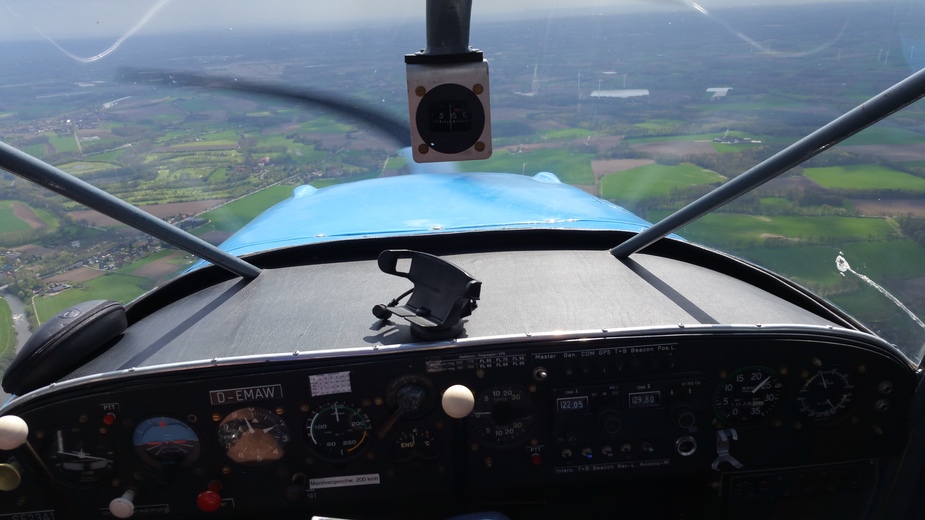
Planning
Since I planned to take a shift at our booth on Wednesday, I could only travel on Tuesday in this little flivver. Even early slots wouldn’t leave enough time to go there and change clothing after landing to be representable at our booth. In the end, going on Tuesday saved me a lot of hassle with slot reservations and anger about stupid slot systems, although it has been reported that a simple call the day before was sufficient to get a last minute acceptance.
Everything you need for flight planning:
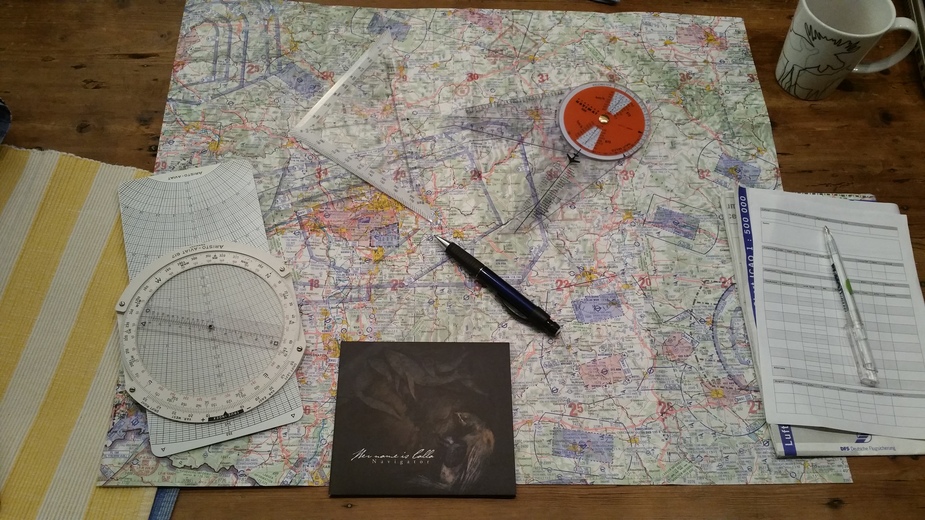
The Sperling is a bit short legged with just two 38 liter tanks, consuming a tad more than 20 liters per hour, and it was my first longer tour with the bird, so I initially decided for two fuel stops on the trip to Friedrichshafen. Plus, it gave me enough fuel to not refuel at EDNY and get some Mogas on the return trip.
It isn’t that easy to find Mogas-serving airfields, that are open on weekdays. The concept of an “open” airfield may sound strange, if you don’t have experience with the – let’s say – idiosyncratic way of operating small airfields in Germany. Many Sonderlandeplätze are PPR during the week and/or have strict contingents for foreign aircraft. I felt, that just to save me ten or twenty Euros in fuel, I shouldn’t get someone coming out to the field to “open” it for me, or to steal their amount of free landings.
So on the way to the Aero I planned to go to Verkehrslandeplätze with defined opening hours and someone capable of selling fuel. My routing was from Rheine (EDXE) via Marburg (EDFN) and Heubach (EDTN) to Friedrichshafen (EDNY). My reasoning was, shoud I not get fuel in Friedrichshafen, the remaining amount of fuel in the tanks would allow me to at least get in the vicinity of Stuttgart for refuelling.
Of course, there was enough fuel in Friedrichshafen, so my intended flight back home was planned with only one stop in Mainz, where I would meet my wife and sister-in-law, who were flying the same routing back to Rheine in our Cessna 172.
The complete routing:
Leg 1: Rheine – Allendorf Eder
Getting out of Rheine and being approved through Münster CTR was, of course, a non-event. There was one Aquilla doing circuits when I crossed the CTR, but that’s enough to be cleared through the CTR even before getting the QNH. Visibility was good and so identifying the route was not very difficult. The rather slow cruise speed is very helpful, since even small becks and railroads can be identified very easy. I mostly stayed between 1000 and 2000 ft AGL.
Soest:
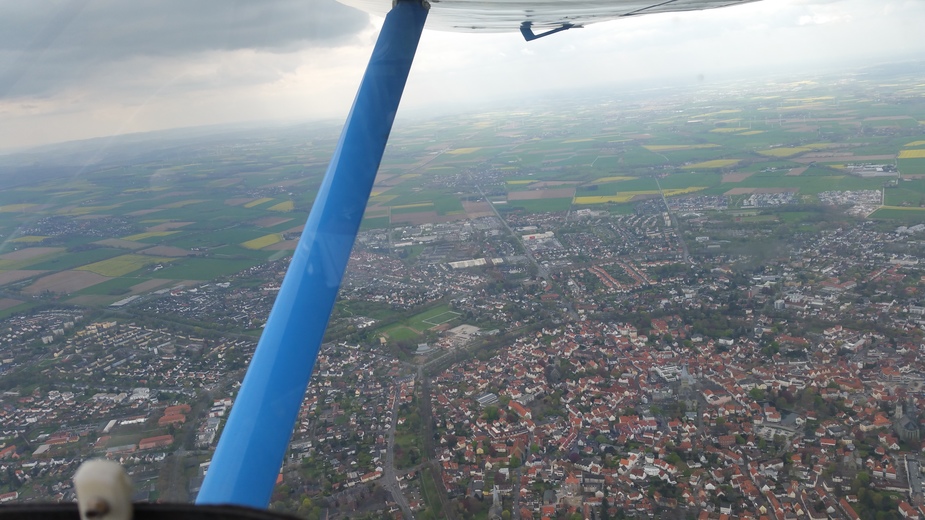
Möhnesee:
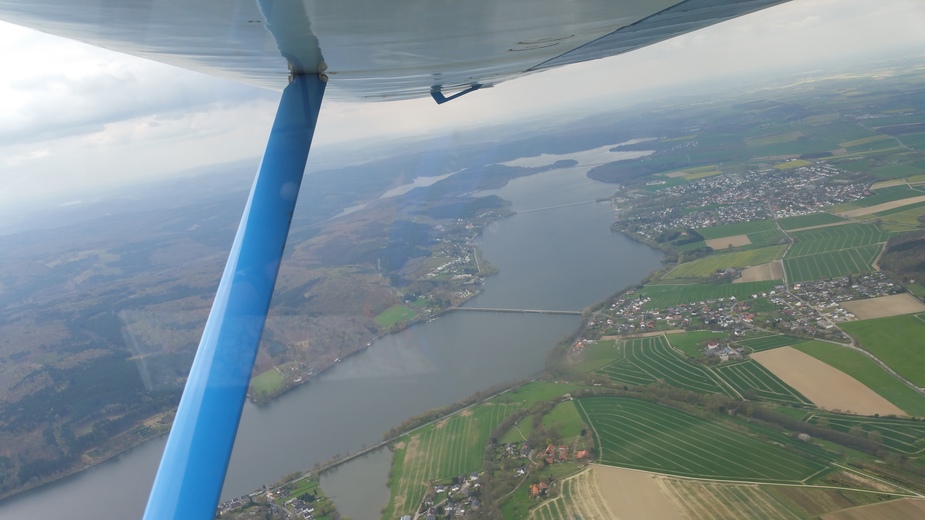
I had a considerable amount of crosswind on my route, around 15 km/h crosswind component was forecasted. Entering the Sauerland, I began to follow some ridges and slopes, if they weren’t too much off course. This allowed for a slightly increased cruising speed at a bit lower power setting. How big the effect was, I don’t know, probably the detours taken had eaten up all advantage of tactical flying. But it was fun to listen to the engine picking up a couple RPM and the airspeed jumping from leisurely 150 to pacing 170 kilometres per hour.
Sauerland:
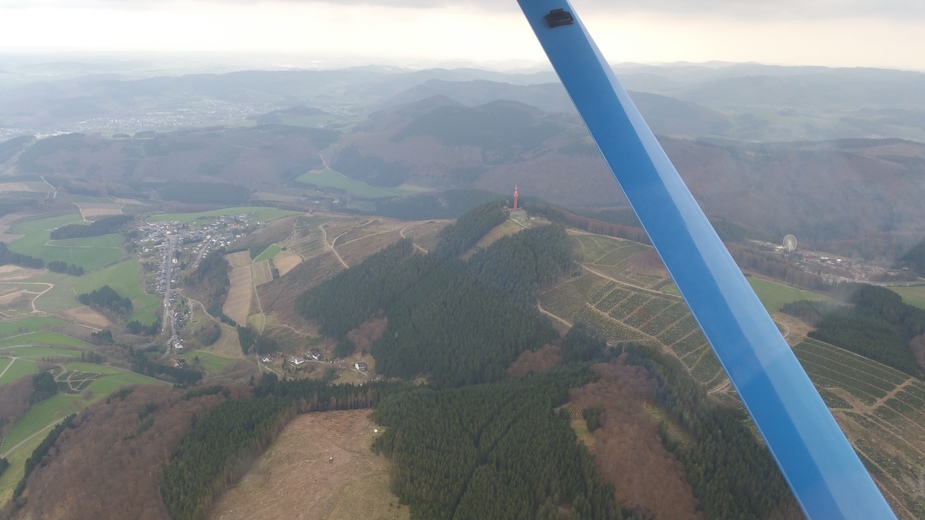
The “Dutch Alps”: Winterberg
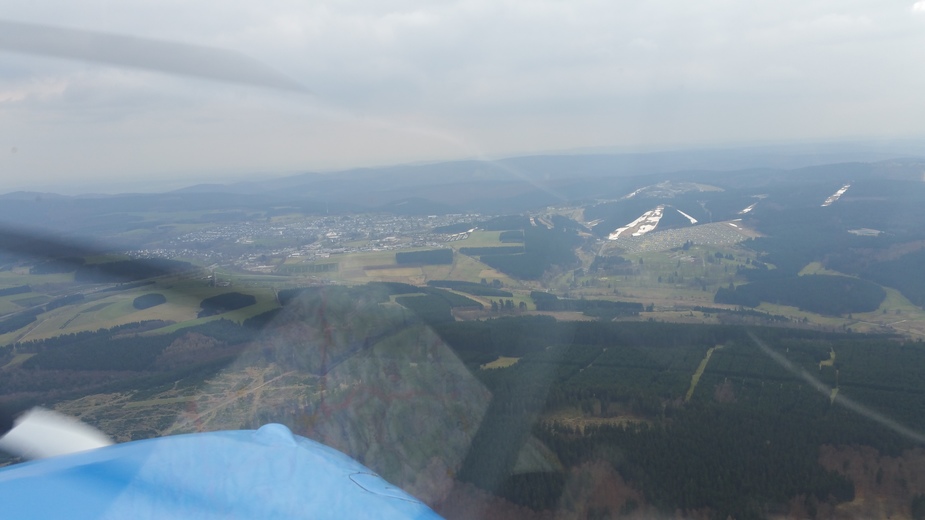
Initially I planned to fly to Marburg-Schönstadt to refuel. Either I have missed the Notam between all the newly erected wind turbines and defunct NDBs, or they haven’t issued one, but Marburg Info told me on the radio that the airfield was out of service due to moisture and a much too soft runway. So I headed back to Allendorf-Eder EDFQ for fuel.
Crosswind correction in Allendorf:
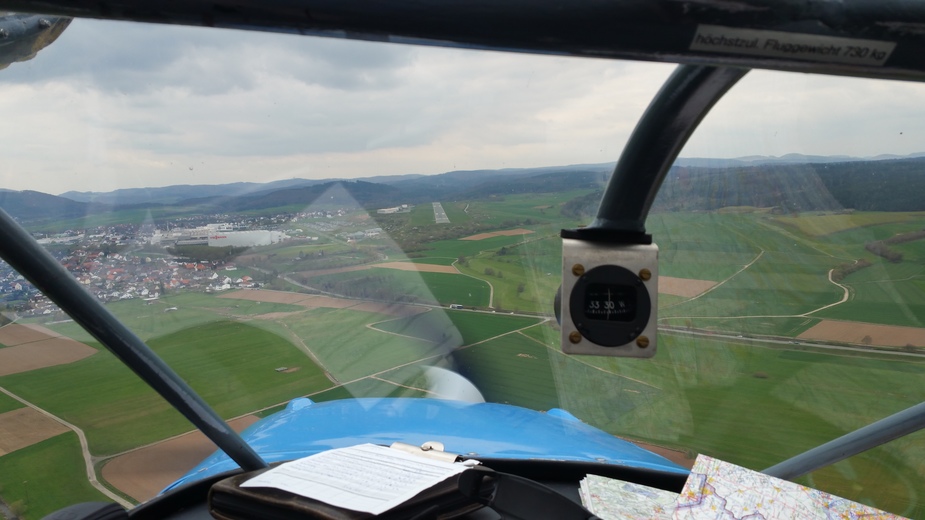
I haven’t had any experience about the fuel used by the Sperling in cruise, I always estimated it to the safe side with 24 litres per hour. Thus the amount of fuel I managed to fill into the tanks were a whopping 22,8 litres after 66 minutes of flight. There is not much you can do in the Sperling for fuel efficiency, as the Stromberg carburettor is adjusting the mixture automatically, at least in the altitudes I flew. I was amazed to learn that Allendorf would not accept cards, only cash or an Invoice by Viessmann. Allendorf is one of the better examples of a company operating an airfield nearby.
Sperling in Allendorf
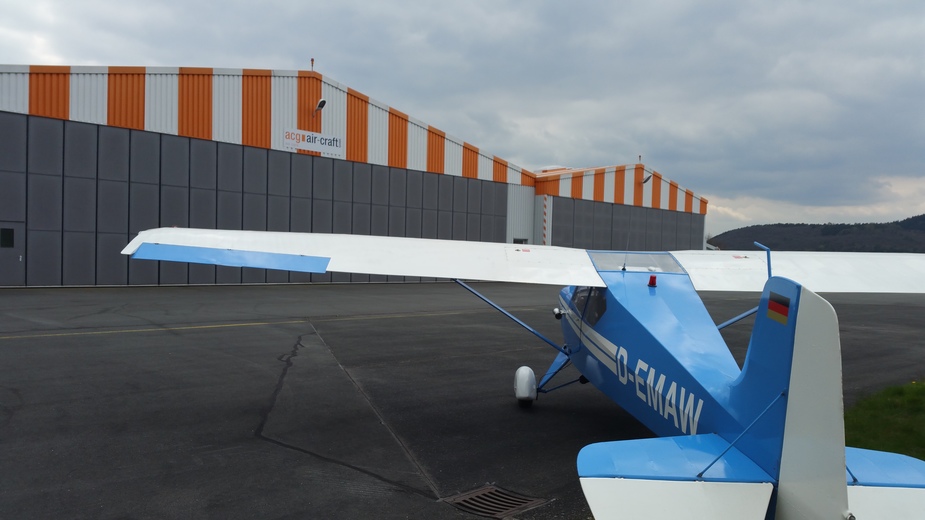
Leg2: Allendorf – Heubach
One of the beauties, flying low and slow, is the sightseeing you do in between. Sure, the view from FL65 and above is great, but it doesn’t change that much and details blur. This kind of cross country flying gives a complete different appreciation for the land overflown.
Bündingen with its castle:
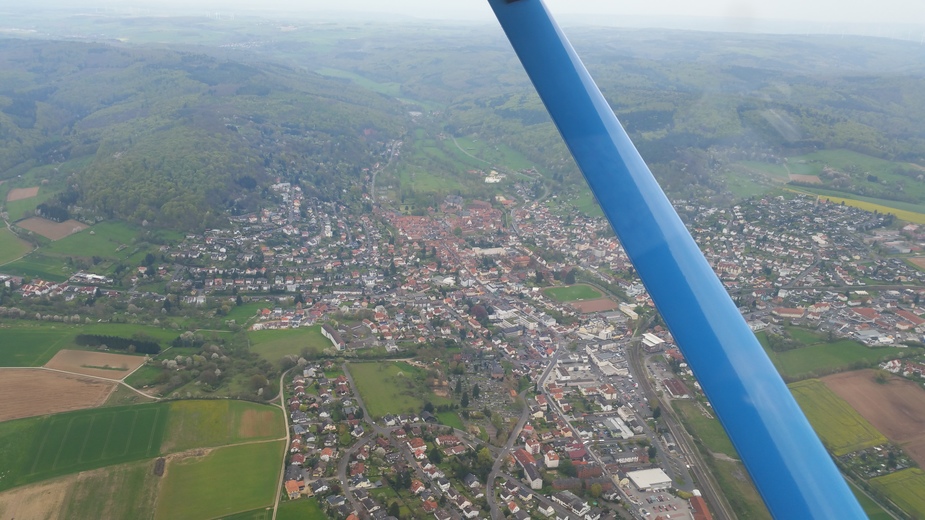
Waldenburg:
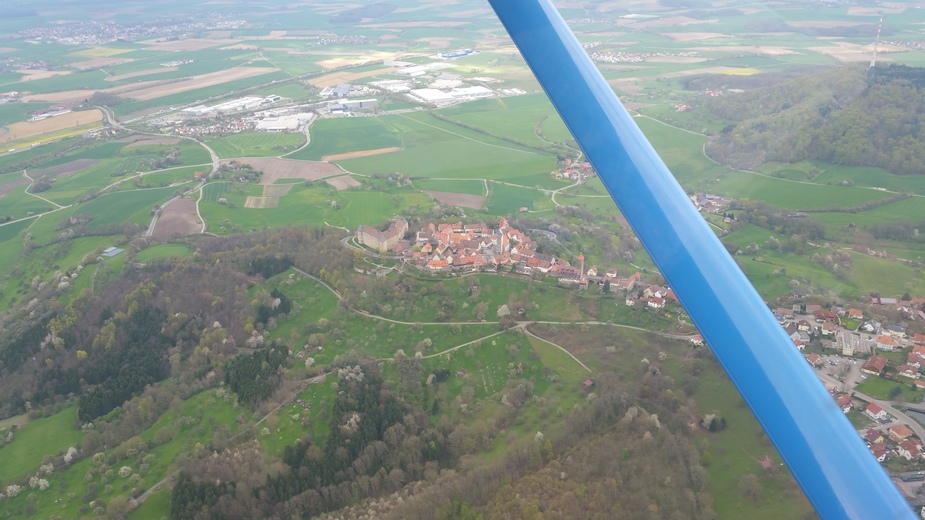
Initially I planned to visit Heubach, because it is home of Scheibe Aircraft and I intended to drop by and say hello. But as usual I was a bit behind my schedule and the colleagues waited for me in Friedrichshafen already. So after a quick refuel, I went up again.
Sperling at Heubach:
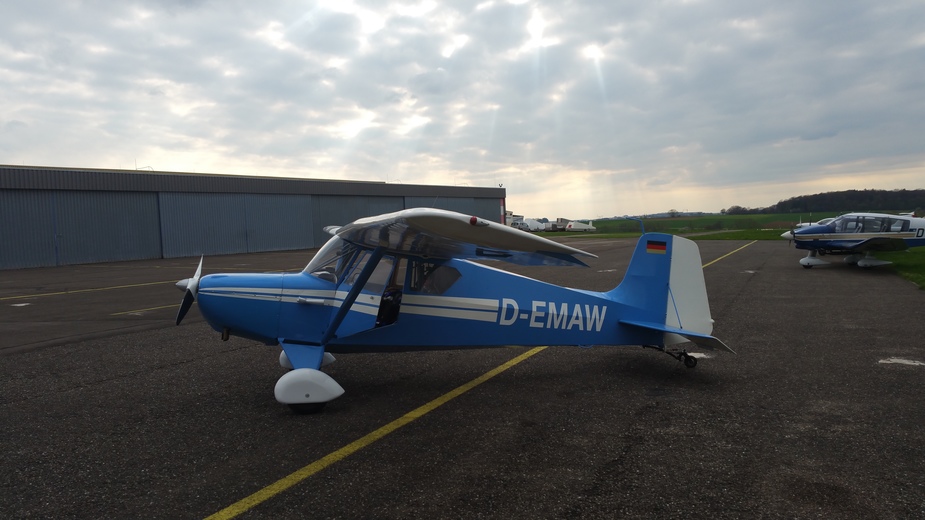
Leg 3: Heubach – Friedrichshafe
Passing Donzdorf the weather changed fom CAVOK to severe CAVOK and the last bit of the journey towards the Aero was even easier.
Severe CAVOK:
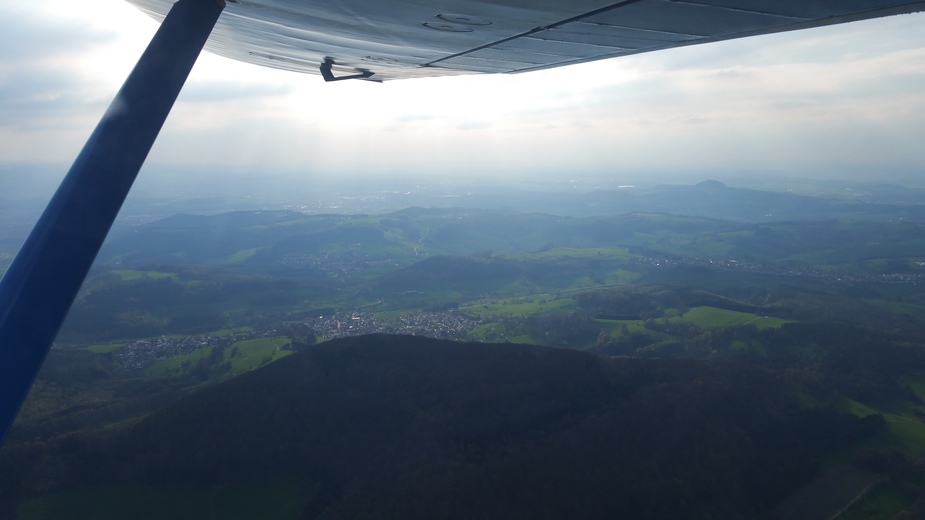
Geislingen an der Steige:
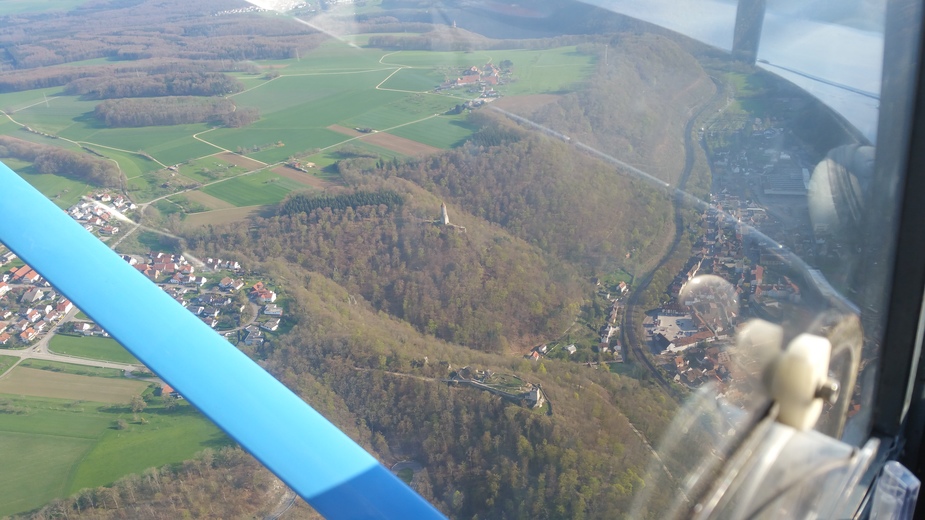
Approaching EDNY:
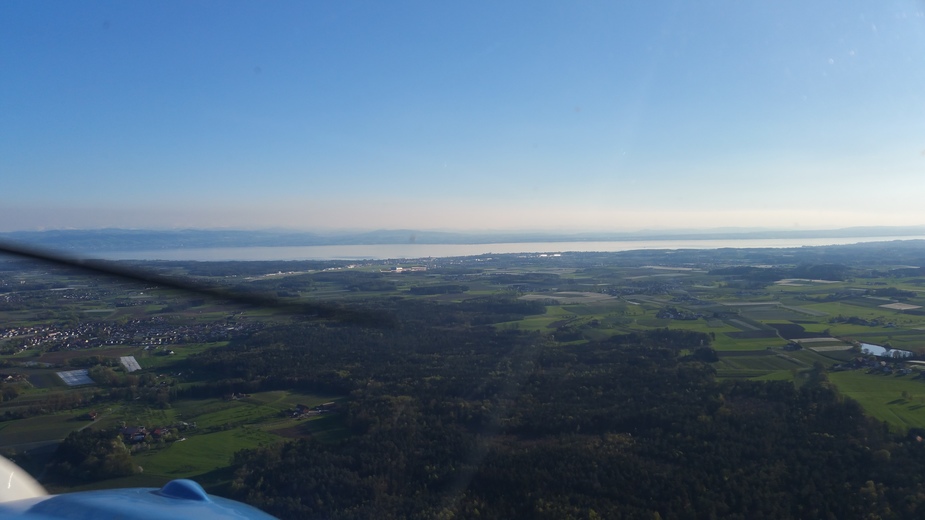
Final Runway 24:
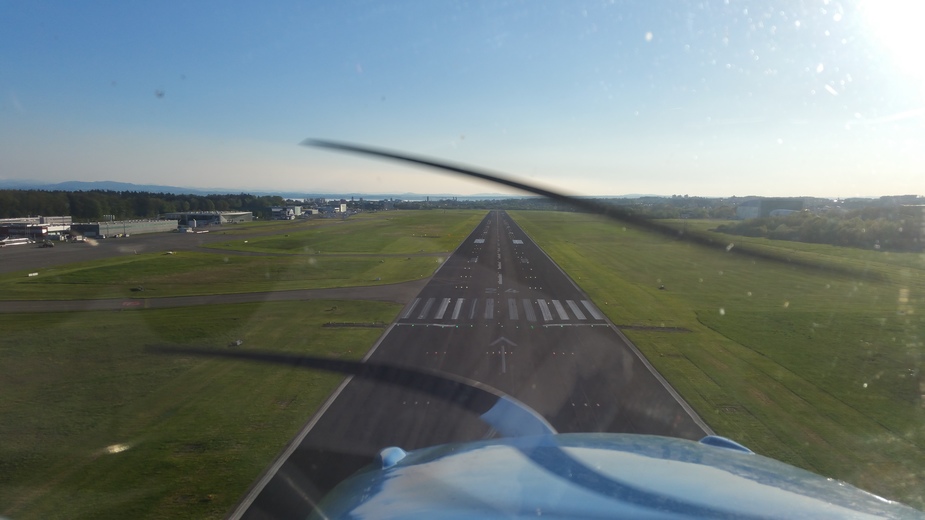
Still empty:
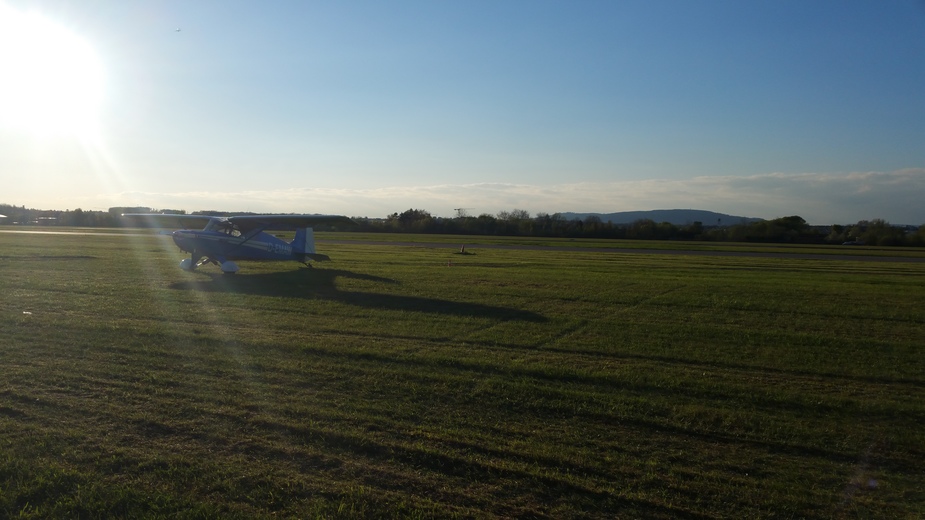
Leg 4: Friedrichshafen – Wächtersberg – Mainz
I initially planned on returning on Sunday, but the forecast was so bad that I changed some shifts and schedules at the aero to be able to head home on Friday. My wife also altered plans and went Thursday to Friday, instead of Friday to Saturday, as we had planned it in the first place. (She just called Ops and negotiated a slot on the phone without any hassle. One has to questions the sense of this system).
We planned our flights in the Café at the Zeppelin hangar. As I was again flying without any other form of navigation, I had to make a complete flight log and calculated wind correction angles and ground speed with my Aviat. However, some “pilots” weren’t above issuing some idiotic comments in the fashion of “Oh look, they even need to do a flight plan like in flight school!”. The intonation was clearly derogative and It really got me angry. They did not know anything about the fellow pilots planning their flight. My wife with the anticipation that she will have to explain a lot to her sister during flight, and myself flying solo without any electronic means of navigation. I could not have done this on the fly, and I think my wife showed a great deal of airmenship in deciding she needed to be well prepared for that flight. I hate the feeling that some of these comments will be thrown at less sophisticated aviators who then neglect what they need for the flight and eventually endanger themselves and the lives of their passengers, possibly tangling with new aircraft and adverse weather. I think a pilot doing a proper preflight planning is a great thing and anyone belittling them is a huge jerk.
The departure from Friedrichshafen was very straightforward and nicely handled: Listen to ATIS, taxi to holding point Runway 24 and monitor TWR. Then you have been addressed with your callsign and asked about preferred departure route and after that you have been issued a take off clearance. Very nice, smooth system, in contrast to the embarrassing system with the slots. When I got my take off clearance, a Jetprop was instructed to line up and wait. It was a bit strange to have a much faster aircraft lining up behind, and I hoped that this pilot wasn’t one of the Murphys who issued their own take off clearance. Such a little flivver as mine can easily be overestimated in speed.
Taxiing
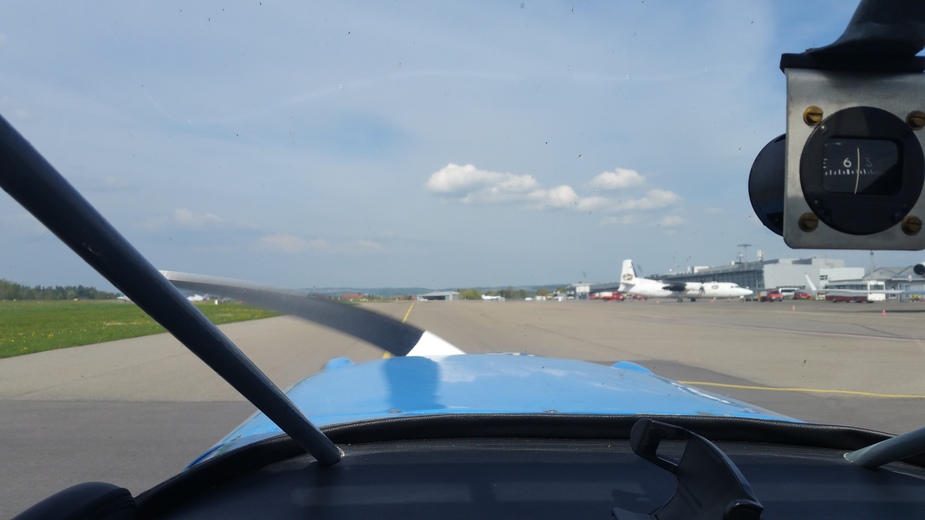
When I was airborne, the controller asked me if I could do a right turn as soon as possible, which was already anticipated by me. Obviously he overestimated my speed, too, but I was happy to comply and turn overhead the trade fair.
Airborne again:
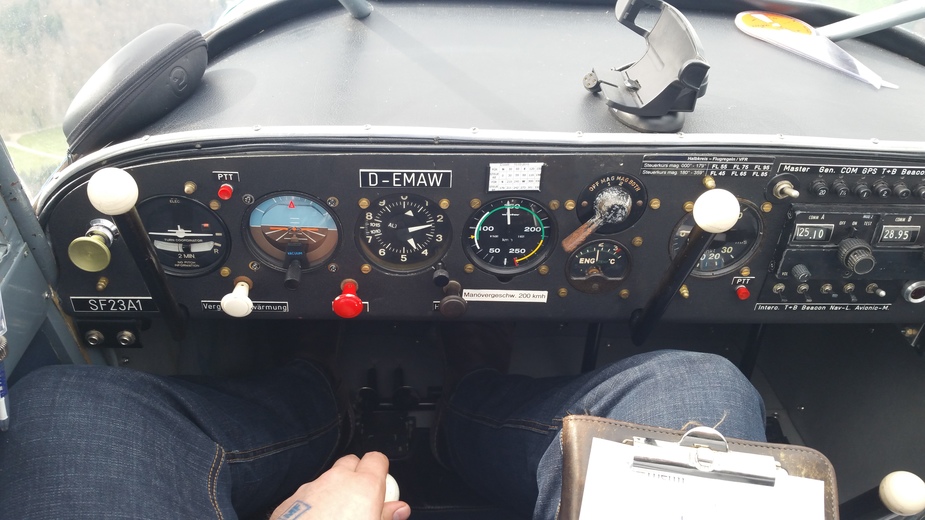
I had a considerable headwind, leaving me with about 140 km/h over ground, thus I had more time for sightseeing. I calculated that I would land some 15 minutes before sunset in Rheine, so it gave me a bit time for miscalculations and changing winds.
Burg Hohenzollern:
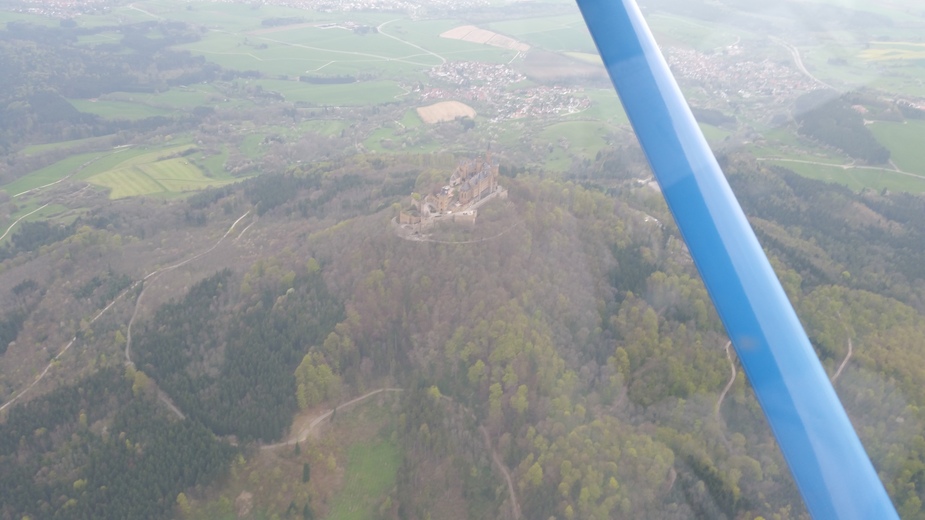
I just passed Wächtersberg airfield (EDSV) , when my oil pressure started to drop. At first just a bit and I thought this came from the new installed oil filter and she would lose just some droplets. But before even reaching Calw, the oil pressure dropped into the top of the yellow zone and I decided to turn back to Wächtersberg. The next airfield on course would be Bruchsal, but that was too long for that considerable drop in oil pressure. I know that my wife was on FIS so I called her and we switched to 122,8 to sort things out. She said she would fly to Mainz and after landing she called me about the further plans.
After the big drop in oil pressure I was sure it couldn’t be the oil filter. If I had lost the complete assembly, I sure wouldn’t have had any oil left and that clearly wasn’t the case, judging from the remaining pressure. I briefly noticed some oil coming out of the cowling hatch. I used my phone to verify my sightings. Two minutes later I had landed in Wächtersberg. I was amazed of how little the oil temperature was rising with the loss of oil, I expected more in these cases.
Reading of the oil instrument:
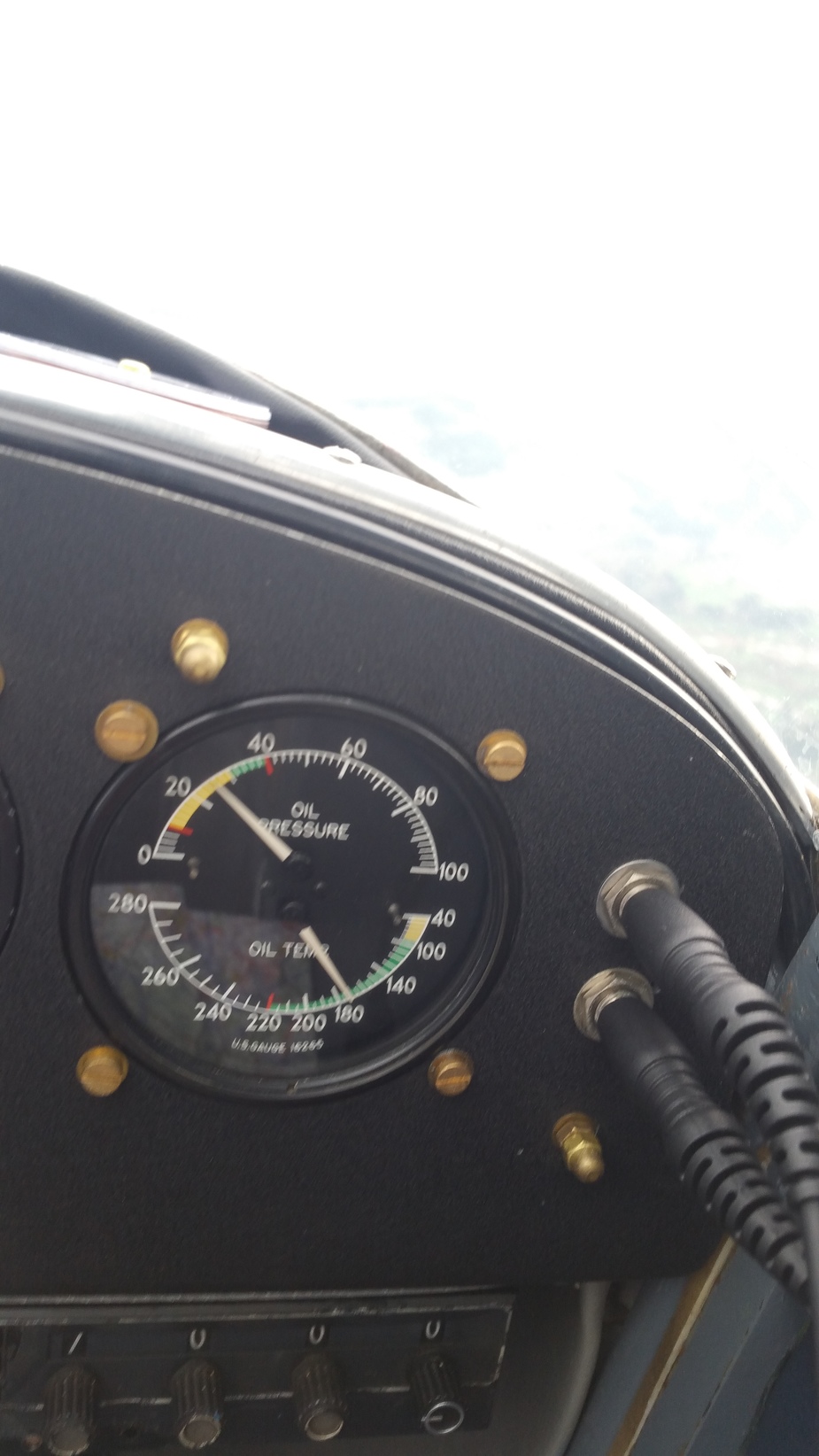
Oil on cowling hatch:
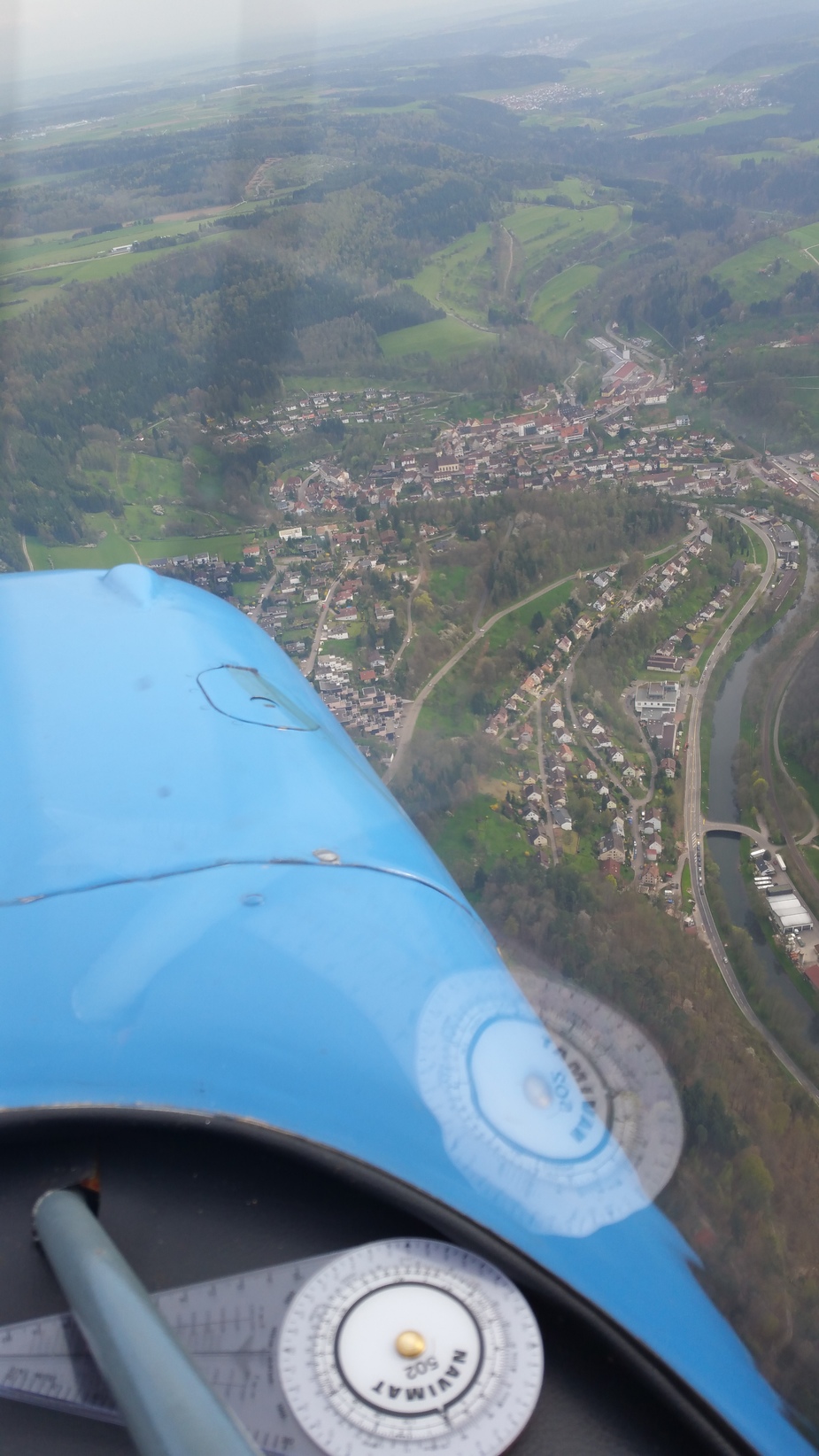
Inflight decoration of the aircraft:
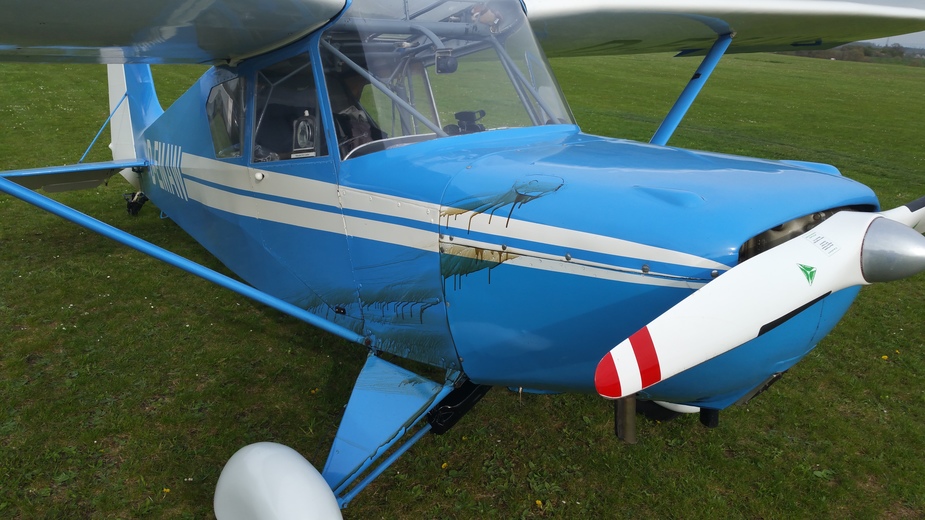
The C-90 (and its successor, the O-200) has a little resistance when closing the oil cap. This shall prevent the oil cap from vibrating open. Now with a little late on schedule and sweaty hands and a bit oil on the cap, I somehow confused this resistance with the complete stop when closing the cap after checking the oil quantity in Friedrichshafen. I don’t know if it was then, when I got distracted as my sister-in-law asked me for my fuel dipstick, but it might have been contributing. No excuse for failing to completely close the oil cap, though. Somewhere between Friedrichshafen and Wächtersberg the oil cap must have gotten lose and the oil was sprayed all over the engine department. I later recieved the tip to mark the inflight direction of the proper closed oil cap and I will apply this to all our O-200/C90 engines.
The culprit:
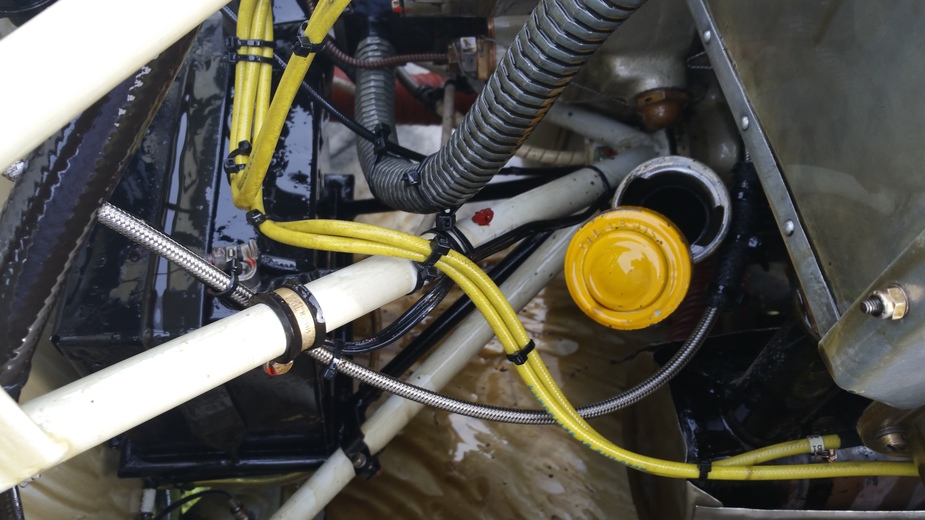
In Wächtersberg there were two older pilots who were able to provide me some tissues and sold me three litres W100. They did not know what the aero club sold the oil for, but we agreed that I’d pay whatever aircraft spruce listed in their webshop. After I refilled the oil, I calculated that I landed with one litre left in the engine, out of 4,7 litres.
Cleaning the aircraft (at least to a point where I could proceed flying) and filling up the oil took around 90 minutes, so there was no chance I would make it to Rheine in daylight. So my wife said she’d wait in Mainz and we’d fly VFR night to Greven (EDDG) together, where we were picked up by my parents. This way, my wife could complete her night VFR rating, on which only the night cross country was missing. Greven charged just 10,50 EUR landing and overnight fee for our old 172 (998kg MTOM).
Speyer:
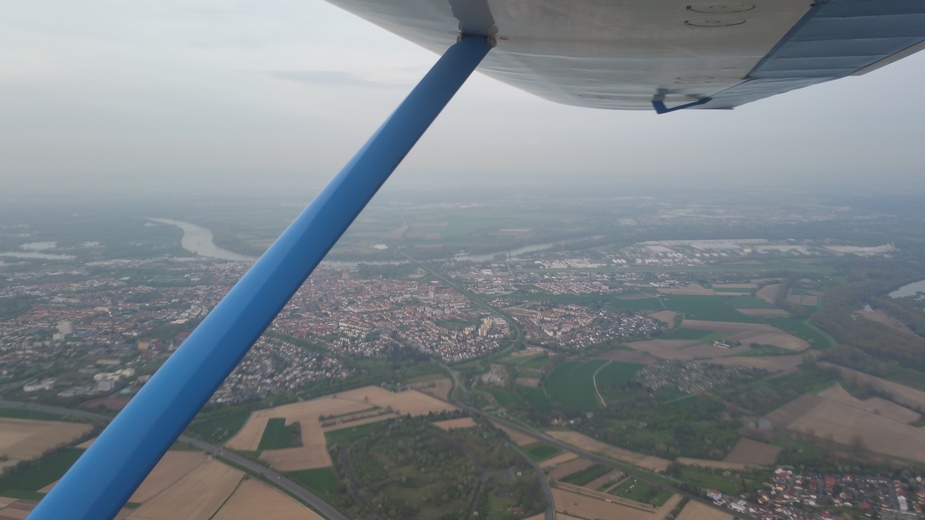
The Flugleiterin in Mainz was very helpful and stayed a little longer for us to get airborne. She even called AIC and provided us with our first radar frequency and the squawk.
Takeoff in Mainz:
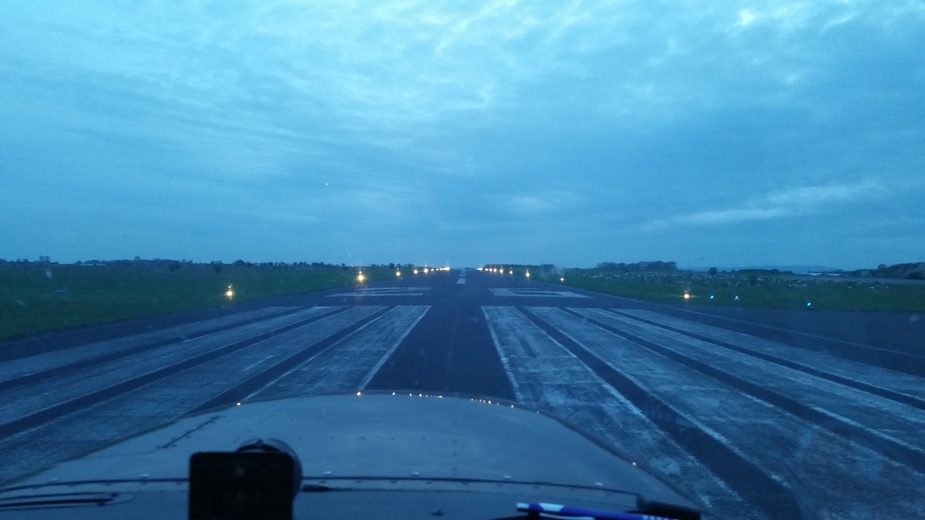
Leg 5: Mainz – Rheine
The next day was marginal in the Frankfurt region and forecast promised good weather behind the cold front (Rückseitenwetter) with some showers but acceptable ceilings and visibility outside of the showers. We decided to go to Mainz by car because of the presented timeframe and the possibility that the front would be through later than predicted. So if the weather would have prevented a flight back home, we at least could secure the aircraft a bit better than I was able to do the evening before. Or we could even find a place in a hangar to have her wait for better weather.
But the meteorologists did not lie and I was able to go to Rheine on a more or less direct course.
Cold air masses abeam Frankfurt:
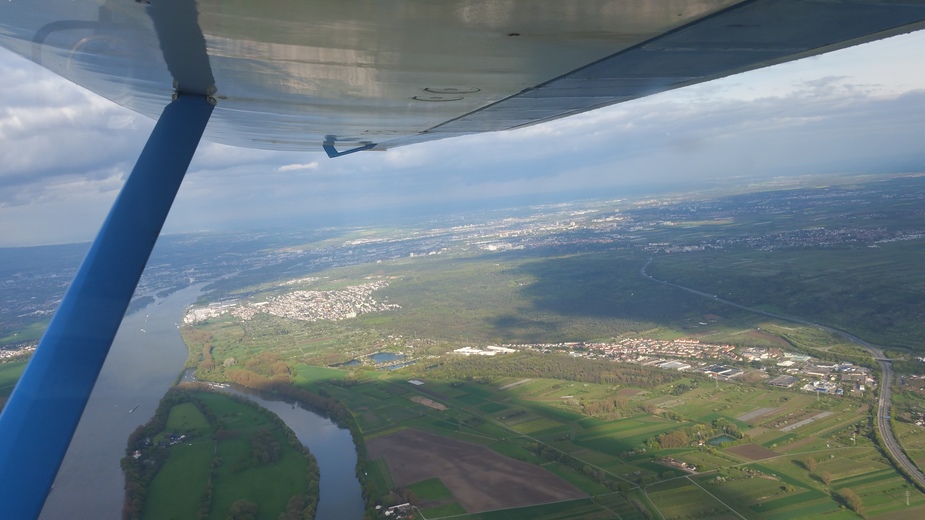
When flying the Sperling, it is very assuring that the V_A is way above any reasonable cruise speed, so turbulence is a non-issue – at least structurally. This allowed me to circumnavigate the showers quite close and take advantage of surrounding updrafts, compensating a bit for the increasing headwind. I had planned with a mere 130 km/h ground speed (at 150 km/h indicated), but lost at every checkpoint one or two minutes, so I flew probably closer to 120 – 125 km/h above ground.
Showers west of Ailertchen:
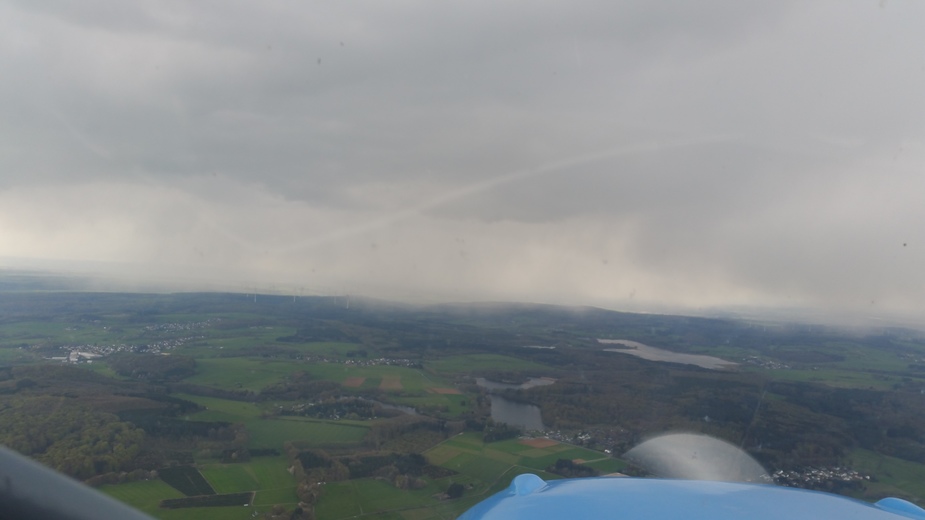
On the other side of the shower:
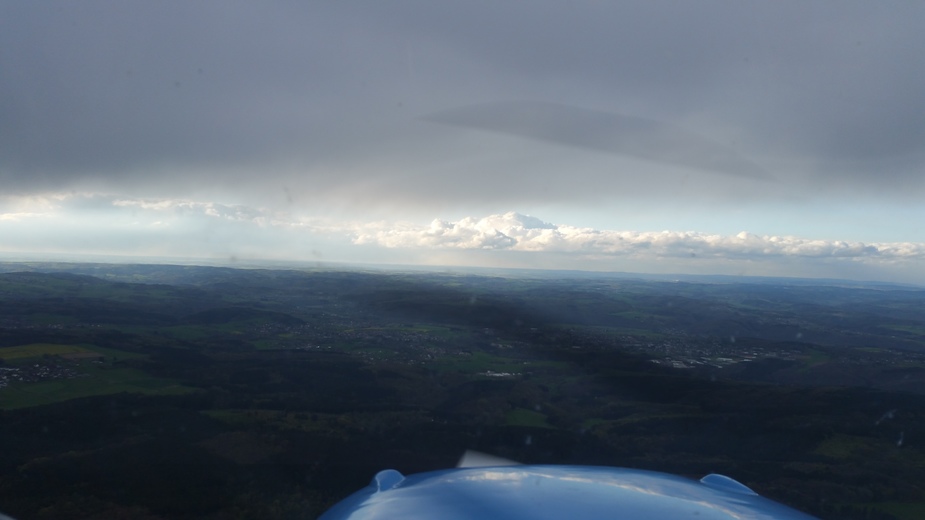
North of Gummersbach:
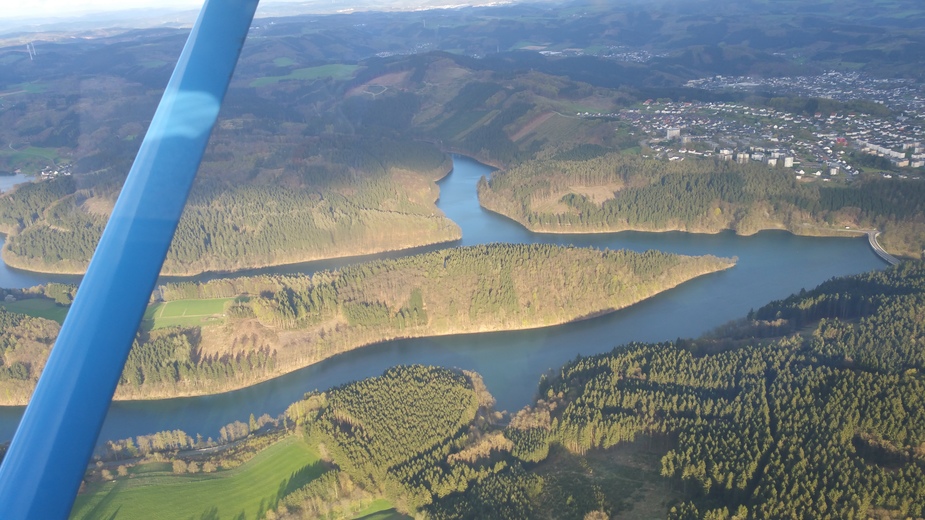
Lüdenscheid:
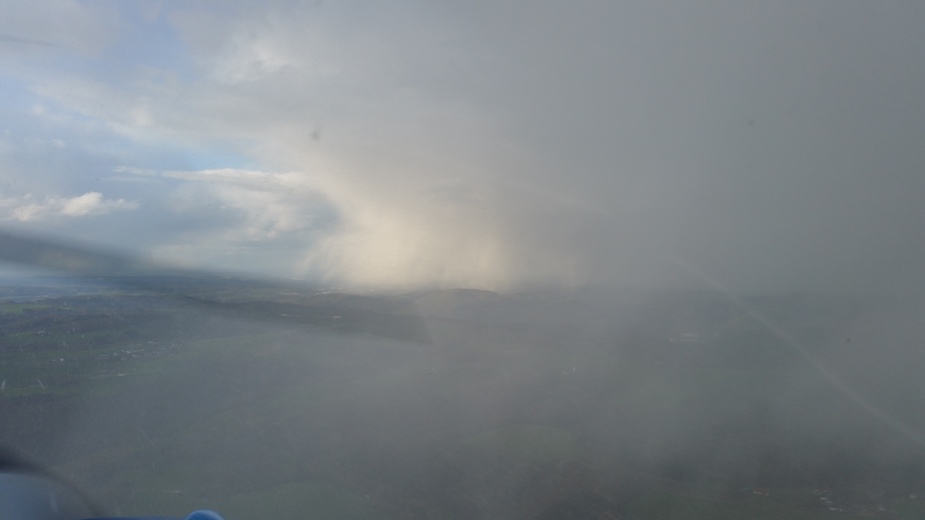
Many showers contained quite a bit of snow:
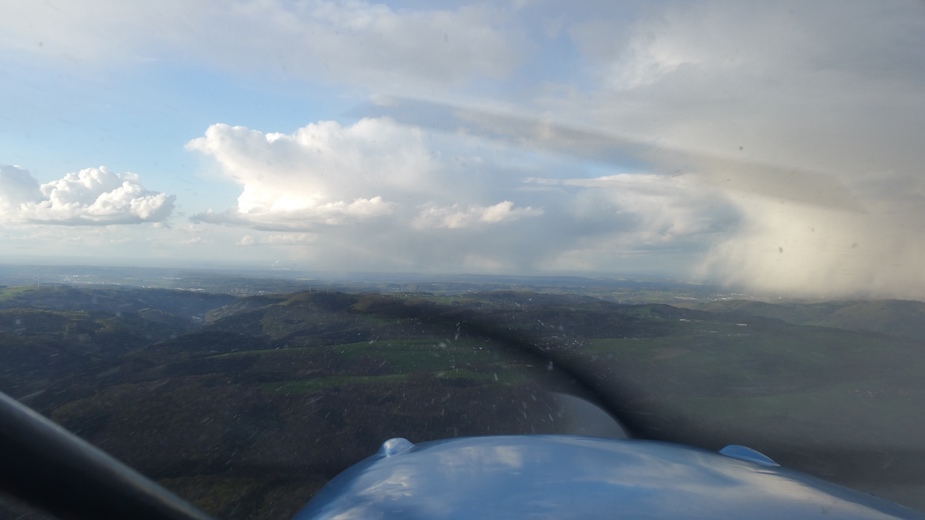
Iserlohn:
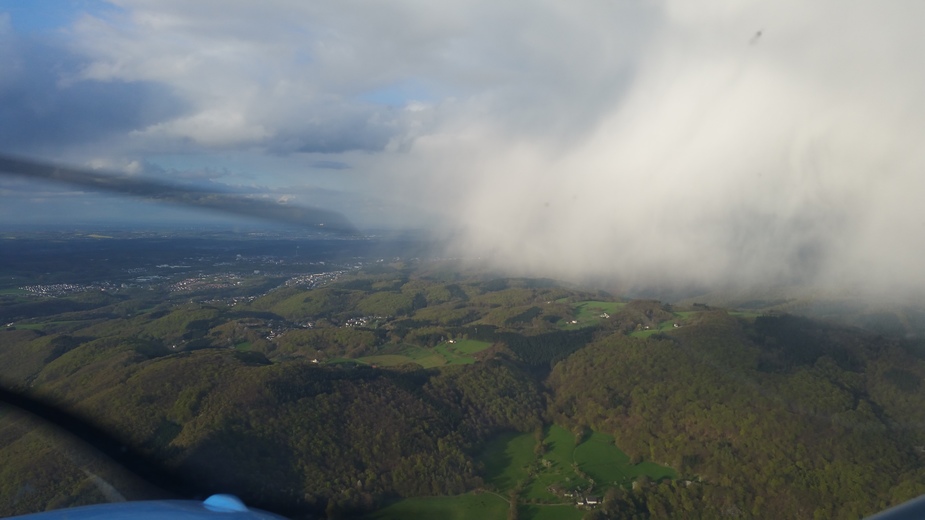
Crossing the CTRs of Dortmund and Greven was, as estimated, a complete non-event, even when I must have looked like a static obstacle on the radar screen, rather than an aircraft.
Dortmund Airfield:
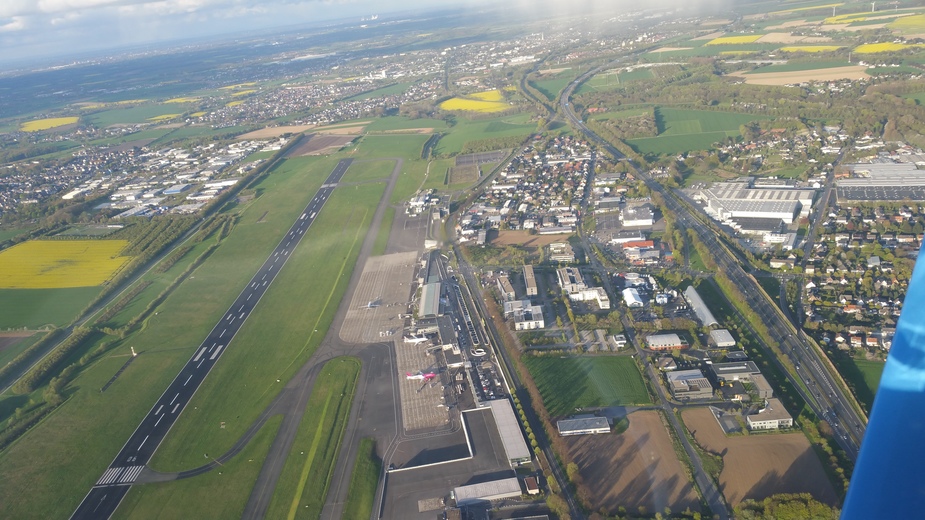
Dortmund City:
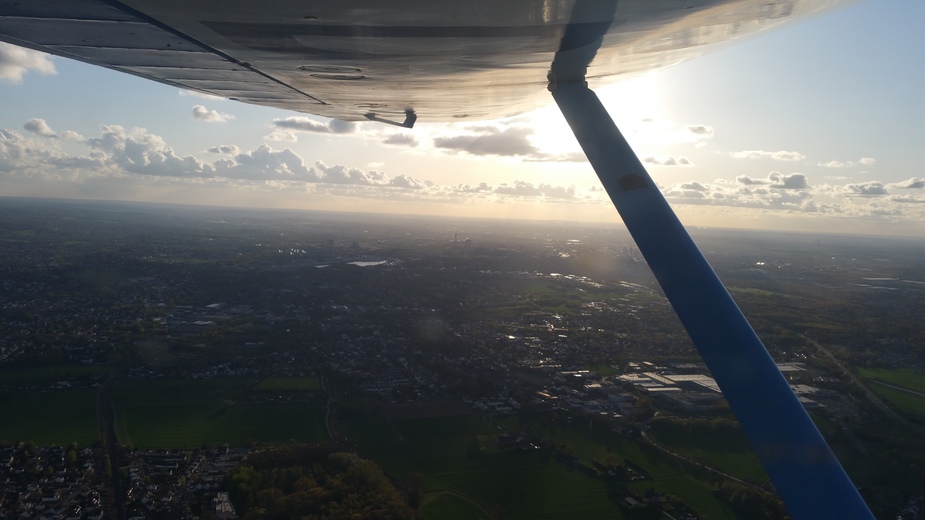
Shower over Münster far away:
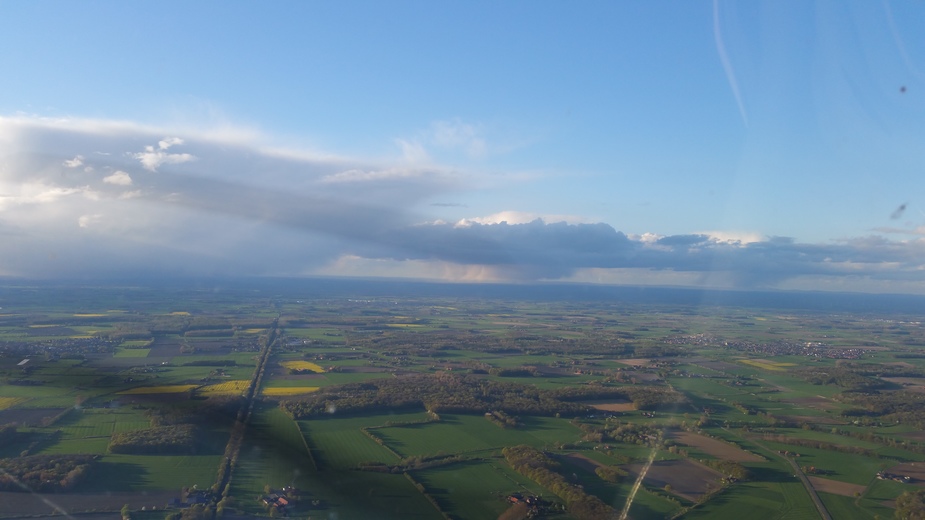
The same shower a bit closer:
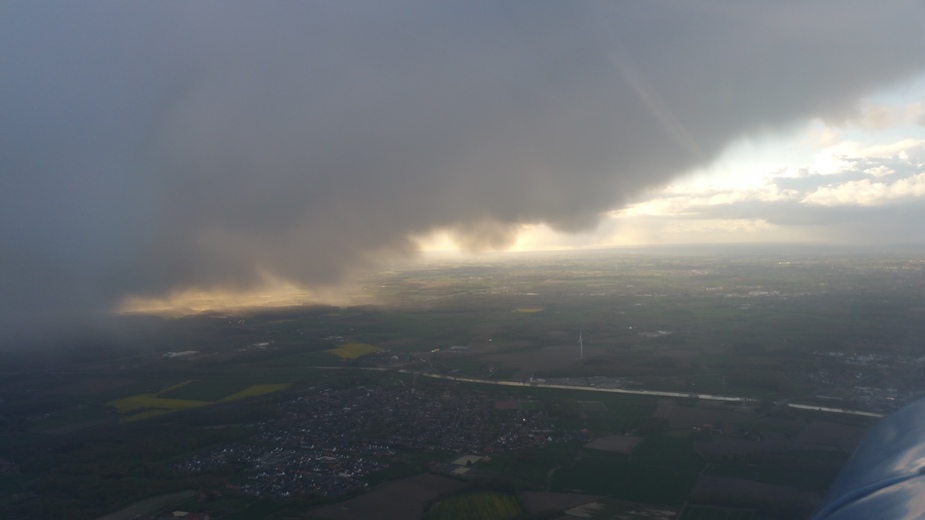
No picture could possibly catch the pure beauty of nature:
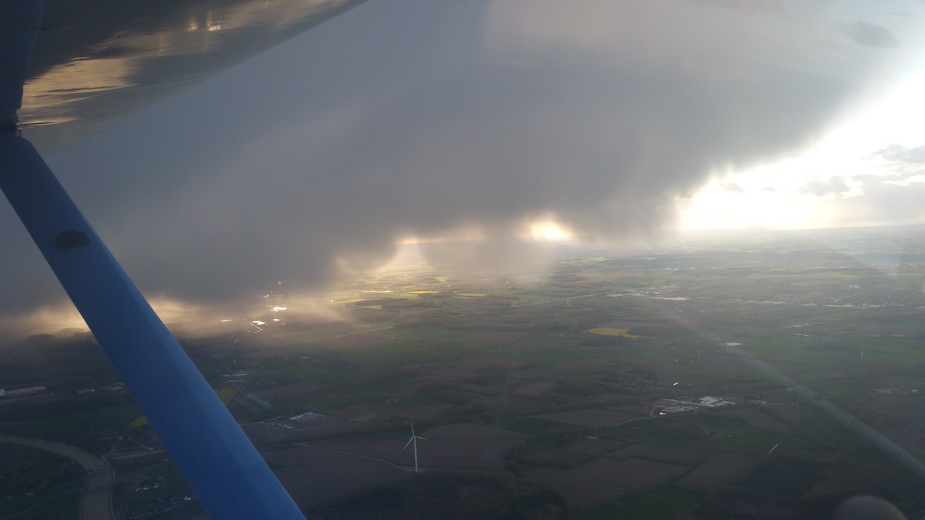
Between the showers the cold air was clear as it could get.
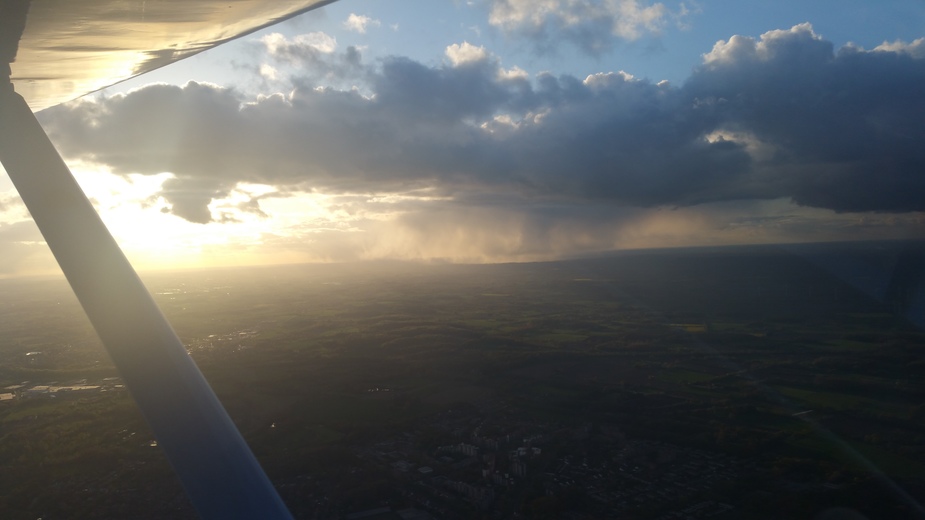
Landing in Rheine was interesting though, since the sun was very prominent, so that I had aborted one approach due to lack of visibility. Luckily there was a cloud providing some shadow on the ground so I could sideslip into the shadow (having the wing blocking most sunlight) and land with sufficient visibility. The alternative would be a landing with a slight following wind component, but I had never done that in the Sperling before and I felt like trying the shadow first.
Turning final the first time:
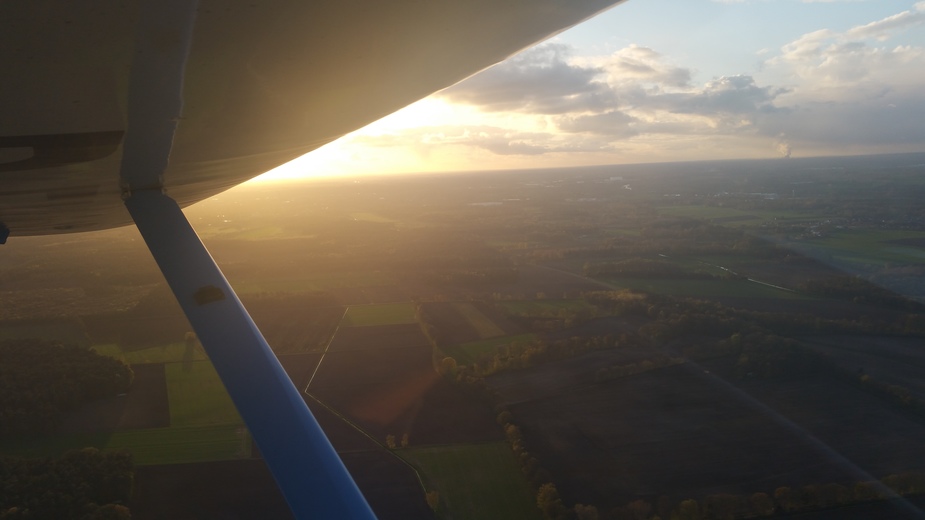
Guess where the airfield is:
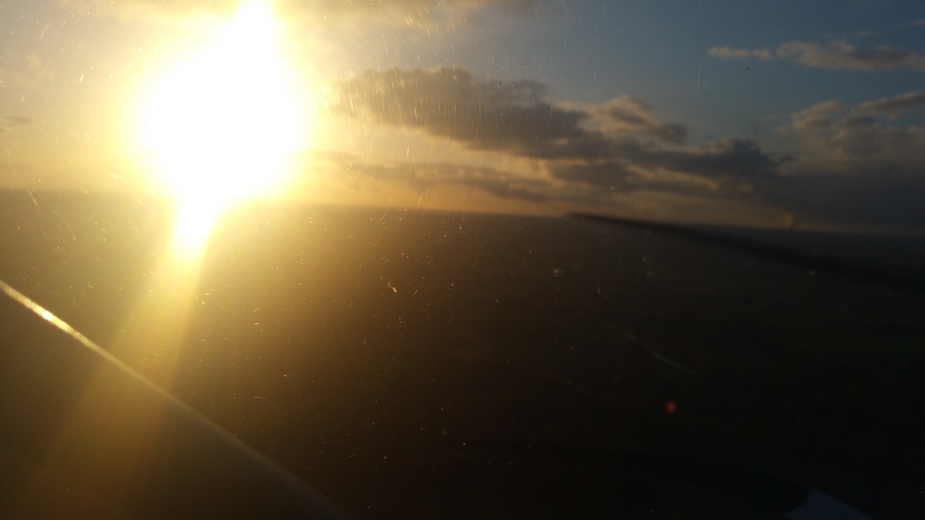
Landed at the second attempt with a little help from the clouds:
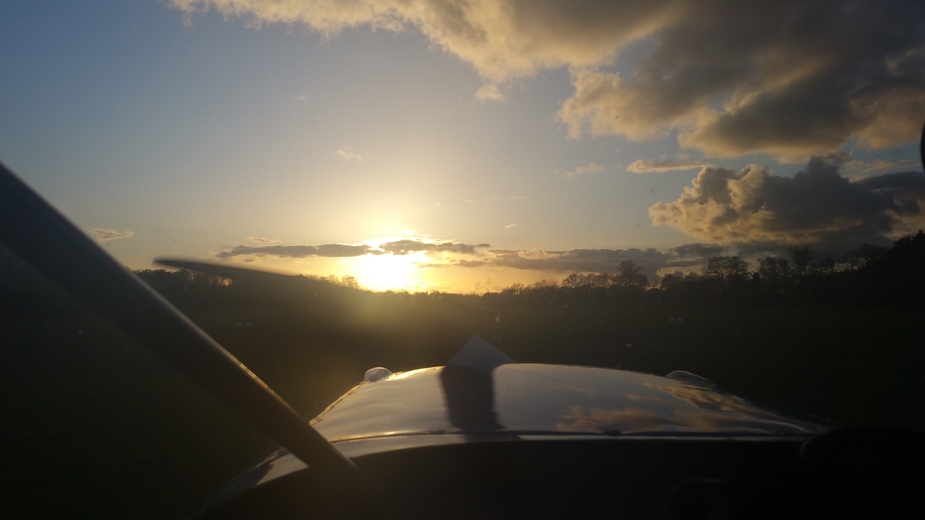
Lessons learned:
It is very possible to navigate through Germany with just the basic tools. If you calculate with a conservative cruising speed, you don’t lose very much in time and the wind correction usually was correct enough to be useful. It simply worked. And I can imagine only very few more satisfying ways to travel – if you have time :-)
Of course, it is a much higher “workload” for preflight planning and flight execution, than flying with the help of a sophisticated moving map system. But bugging along with that low ground speeds along a magenta line gets boring quite easy. Navigating in a traditional way kept me occupied and trained what I am teaching as basic navigation skill to my students (before I show them Skydemon :-) ). I would love to make farther tours with the little bird in exactly this manner, and I need to find more time to do this. When I am a bit off the airfields, turning off the radio and listening to the engine and navigating low and slow is like meditation. I seldom have made such a relaxing flight.
Checking the engine instruments all the time is vital, as is a proper preflight preparation. I blame me in letting me getting stressed and not checking the oil cap well enough. But it did turn out well and I have another lesson to teach. And it is never good to do things around an aircraft in haste. If you are under stress, go back, calm down, drink a cup of coffee and start all over again. Haste and planes don’t mix.
Furthermore I will make even more clear that no pilot should feel like he must be excused to perform a proper preflight planning. Next time I will speak up to anyone who issues such comments as witnessed in Friedrichshafen, as those disqualify any person as an aviator.
Thanks for reading. Comments to improve either my flying or my writing are very welcome.
Great write up, that looks like a very nice little airplane. I am quite envious of your trip  .
.
Now I understand why my Aeronca Champ (with a C-85) had an ‘extra’ little piece of heavy gauge safety wire that you could pass through a hole drilled through a flange which protruded from the top of the oil cap. Once you had tightened the cap, you could insert the wire through the hole and it would spring to a position so that the cap could not spin out… a useful adaptation!
mh wrote:
Thanks for reading.
Your’re welcome 
I really enjoyed your trip report, as I was flying on the same days (not to the AERO though) some 20.000 or 30.000ft higher. Interesting to see what that crazy weather looked like from such low altitude. We’ve had a temperature drop of over 20 degrees Celsius with snow at the end of April…
Last time I did pure VFR flights that long was when two 300NM navigational exercises were still required for the CPL. One had to be flown solo, the other could be flown with an instructor (but not necessarily). Most students chose to take an instructor along on the first such flight and I did quite a few of them over the years, with my main task being to make sure that the student did not cheat by using a handheld GPS and pointing him back to the correct track when he followed the wrong motorway, which is very easy in some densely populated areas around here. Alas, these flights are not required any more with the new regulation.
Regarding Allendorf/Eder: Incidentally, I was there with passengers the weekend before your flight. I have never been at a better private/company owned airfield before. Super friendly and helpful staff with everything made as easy for you as possible. As our passengers were guests of the company that owns the airfield, we were not charged anything (not even for the drive to and from the excellent hotel) but I guess their fees would have been very reasonable. Unfortunately that place is right in the middle of nowhere, but it is certainly worth a visit, as well as the wonderful hotel they booked us in (http://sonne-frankenberg.de/go/de/14/?gclid=CK_B54C_scwCFdYV0wodvjUENA).
Thanks for sharing! The aircraft looked quite similar to that owned a few months ago by someone we both know  Kudos for flying like our grandfathers did and jerks indeed commenting on this at EDNY in such a derogative way!
Kudos for flying like our grandfathers did and jerks indeed commenting on this at EDNY in such a derogative way!
Scary experience to be left with only one liter of oil and very instructive how easy such a mishap/distraction can lead to a critical situation like that.
I also got an idea, why Lüdenscheid is AKA “Regenscheid” by ist inhabitants 
BTW: I went to EDNY and back at FL 150  Shame I missed to get in contact with you for a Little meet up :-(
Shame I missed to get in contact with you for a Little meet up :-(
europaxs wrote:
The aircraft looked quite similar to that owned of someone a few months ago we both know.
Indeed, it is the very same aircraft :-)
Very enjoyable reading!
Great report! It’s reminiscent of flights I’ve made myself – although I must admit that once I got a moving map GPS I didn’t want to do cross countries without it.
One of my most memorable legs ten years ago was chugging along at 2150 rpm at 1000 feet agl, window open, using the north-south orientation of farm fields and crops as my compass. It’s something everybody should experience, I think.
I was interested to read how the oil pressure dropped off with low oil level. I’d imagined that the needle would start flickering up and down in that circumstance as opposed to dropping uniformly, especially when the oil temperature reading doesn’t seem to have increased that much. Good info to learn from. Hope you were able to get the mess cleaned up without too much trouble!
Would you have been allowed to cross the various CTR’s if not carrying a transponder?
Canuck wrote:
Now I understand why my Aeronca Champ (with a C-85) had an ‘extra’ little piece of heavy gauge safety wire that you could pass through a hole drilled through a flange which protruded from the top of the oil cap. Once you had tightened the cap, you could insert the wire through the hole and it would spring to a position so that the cap could not spin out… a useful adaptation!
Do you have a picture of this?
europaxs wrote:
Shame I missed to get in contact with you for a Little meet up :-(
Hehe, I think we both shouldn’t need to travel that far to meet each other
:-)
Silvaire wrote:
I was interested to read how the oil pressure dropped off with low oil level. I’d imagined that the needle would start flickering up and down in that circumstance as opposed to dropping uniformly, especially when the oil temperature reading doesn’t seem to have increased that much. Good info to learn from.
Well, there was quite a bit flickering of the needle, but at one point the oil pressure did drop significantly. I figure this was when the cap became completely loose. After that it was more or less stable at the depicted state, so I guess there wasn’t any more oil splattered out of the engine.
Jan_Olieslagers wrote:
Would you have been allowed to cross the various CTR’s if not carrying a transponder?
For Münster I am sure, in Dortmund probably too, after a bit waiting. When I crossed the CTR, they had an approaching 737 or A320 or something like that. It depends a bit on how good your impression is on the radio, I guess. But it has happened before. The Sperling, however, has a transponder.
mh many thanks, it sets a high standard for trip reports.
The Sperling seems a refined version (single strut for example) of the Piper Vagabond or Aeronca Chief, with the extra horses of a C-90. What is the history of the type?
2150 RPM is a bit of a sweet spot on the C-90, and it provides a nice 80mph IAS in the 90HP Super Cub. The Sperling might get 90mph at that setting?
I didn’t know about the Dutch Alps, makes the Wicklow Mountains look positively Himalayan.